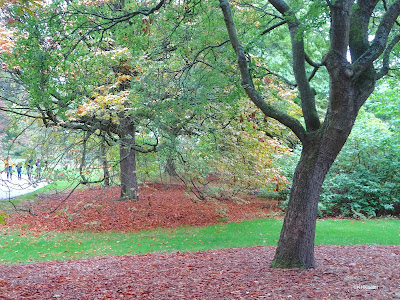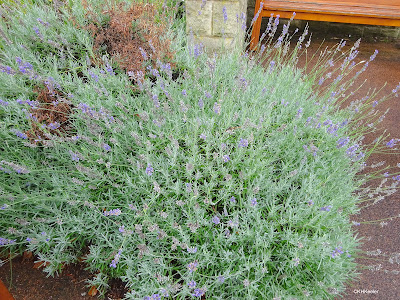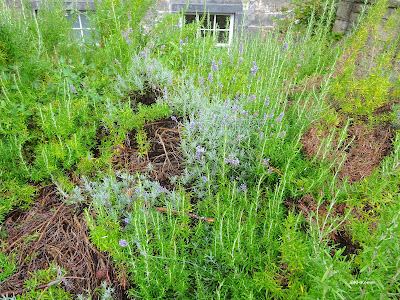It was a rainy September day two years ago when I visited the Royal Botanic Garden in Edinburgh. We walked from our hotel, down old streets and past local markets.
 |
| Edinburgh in September |
The Royal Botanic Garden Edinburgh was founded in 1670, making it the second oldest botanical garden in the United Kingdom.
[And the U.K. is rich in botanical gardens link]. Originally estabilshed as a garden of medicinal plants to assist teaching their uses, today that mandate has broadened to "explore, conserve and explain the world of plants." The garden has moved four times, to ever larger locations. Its current spot is 70 acres, close to the center of the city.
My visit in September meant flowering was sparse. Edinburgh's climate is mild for 55oN, with cold moist winters and cool summers, the winter lows rarely below freezing, summer highs in the 60s F, so winter is late by Colorado standards, but it was still the end of the growing season.
 |
| silver lime, Tilia tomentosa |
I really appreciate labeled trees. The Garden had all sorts of European trees, plants I more often read about than see. It was great to stand by a healthy examples of a particular tree species, labeled so I didn't misidentify it, and get a sense of what it is like. Silver lime is from southern Europe; I am more familiar with the American linden,
Tilia americana.
[Note linguistic differences: I would say linden or linden tree, in the United Kingdom its lime or lime tree, for Tilia species.]
The Botanic Garden has many plant collections: rock gardens, woodland gardens, a Chinese Hillside, collections of Scottish native plants, rhododendrons, and much more. I had hoped to see the greenhouses, especially the Seychelles coconut (Lodoicea maldivica) which they were growing--impressively far from its native Indian Ocean--but the green houses were closed for renovation.
I enjoyed the grounds. The Chinese hillside had this pretty stand of bamboo. I think of bamboo as tropical so it seemed exotic in Scotland, but in fact bamboos grow up some pretty high mountains.
 |
| bamboo (Fargesia nitida) in Scotland |
The path took me past a waterfall through the ferns:
The climate was great for rosemary (Salvia rosmarinus) and lavender (Lavendula species), still flowering in September.
 |
rosemary, Salvia rosmarinus lavender Lavendula species
|
I editted this on 1/15/24. A reader pointed out the photo above is lavender not rosemary. Yes. How embarrassing. But, to edit it out is to make the comment look odd. So I'll add the photo that was supposed to go here:
 |
| rosemary (Salvia) and lavender (Lavendula) |
The afternoon got a bit wet for photography, the photo will have to stand in for the native and useful plant beds.
If I looked carefully, there were flowers elsewhere, though. On this salvia from China, Salvia przewalskii, the flowers were underneath the big leaves. The leaves were over six inches across! The flowers were quite beautiful, and large, if you compare them to, say, the lavender flowers.
 |
| Looking under the big leaves of Ganzi sage, Salvia przewalskii |
Two salvias in this post? Well, Salvia is a really big genus--nearly 1000 species--in the mint family, Lamaicace, the sixth largest plant family with over 7000 species. There are Salvia species native to North America as well as rosemary from Eurasia and Ganzi sage from China, flowers in blues, purples, whites and reds. I am very fond of salvias. Lavender is in the mint family as well, as are many traditional culinary herbs.
As always my observations were quirky. You'd notice quite different things, I'm sure.
Another big European tree, European beech,
Fagus sylvatica. Majestic.
 |
| European beech, Fagus sylvatica |
And from the top of the hill, views across the valley to Edinburgh Castle.
 |
| View of Edinburgh Castle from the Royal Botanic Garden |
The rain wasn't cold, but it discouraged lingering. There was so much there. A beautiful place to walk.
Comments and corrections welcome.
References
Royal Botanic Garden website link (Accessed 1/12/24)
History of the Royal Botanic Garden, Edinburgh link (Accessed 1/12/24)
Why I think the Seychelles coconut, the double coconut, is cool:
(this blog) The World's Largest Seed link (Accessed 1/14/24)
(this blog) Playing Cupid for the Double Coconut link (Accessed 1/14/24)/
Kathy Keeler, A Wandering Botanist









i think, not rosemary, but lavender
ReplyDeleteyes, you are right! I edited to correct the post.
ReplyDelete